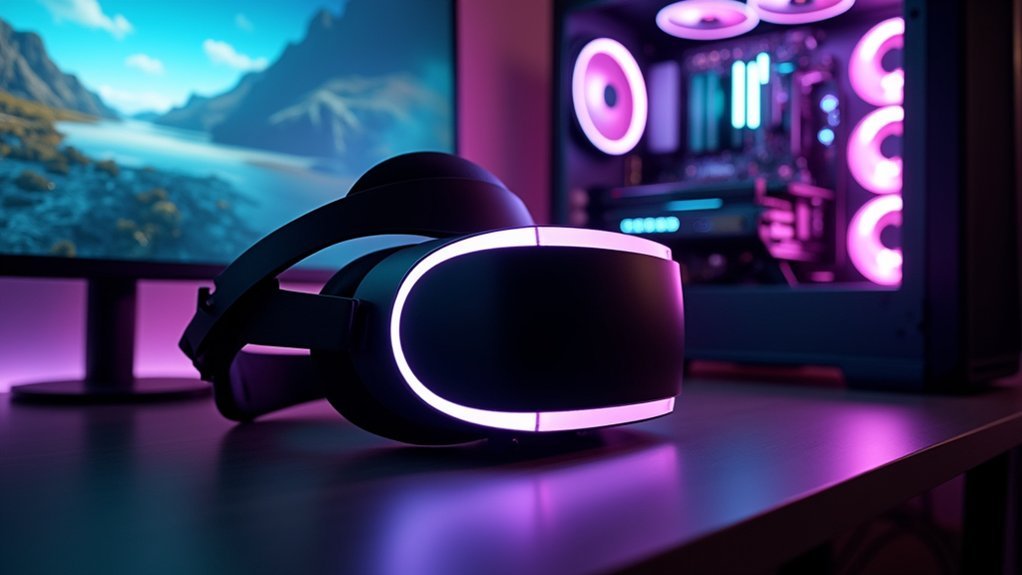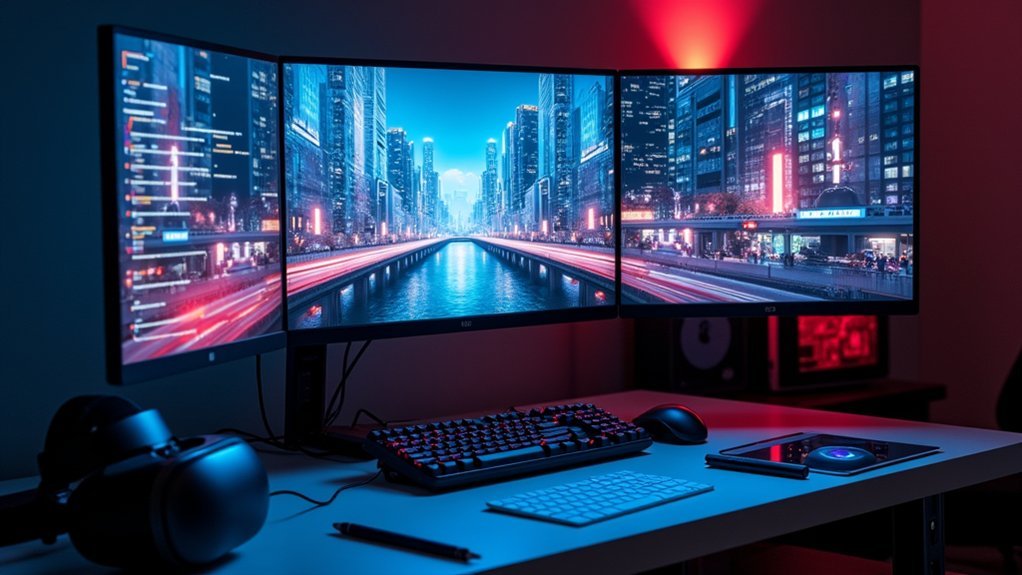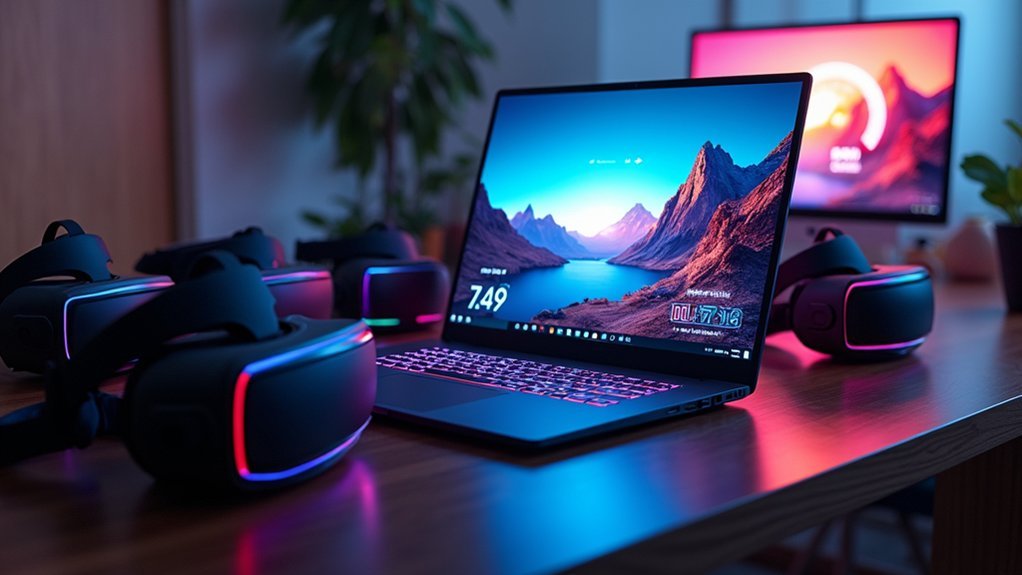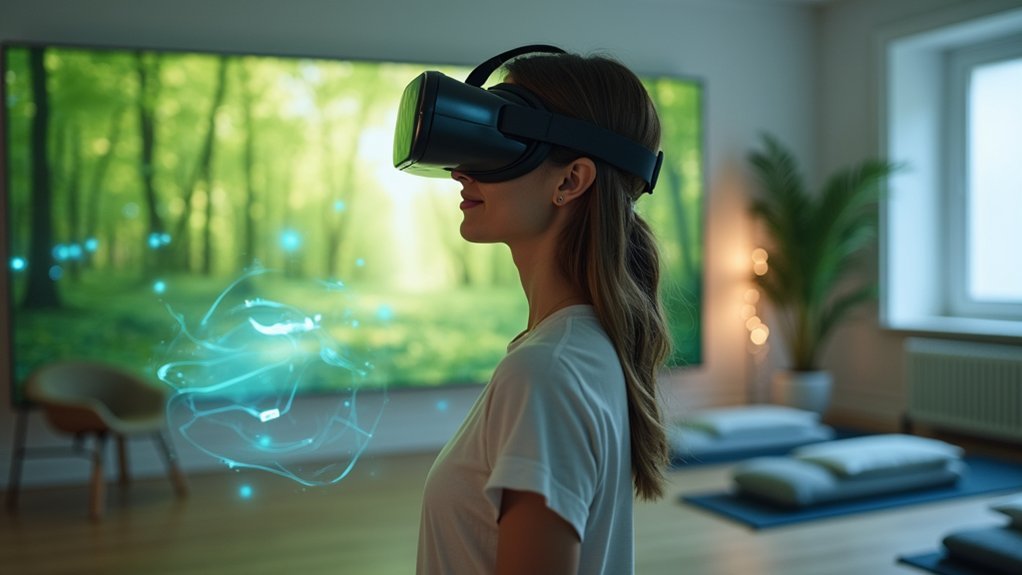You’ll need at least 8GB of RAM for basic VR gaming, though this provides just adequate performance. For smooth, high-quality VR experiences, 16GB is recommended as the sweet spot. If you’re into professional VR development or content creation, you’ll want 32GB minimum, with 64GB being ideal for resource-intensive workflows. Complex VR applications can consume up to 24GB alone, and background processes add to this demand. Understanding these specific requirements and optimization strategies can greatly enhance your virtual reality performance.
Minimum RAM Requirements for Basic VR Gaming

Performance in VR gaming hinges greatly on your system’s RAM capacity. When considering minimum RAM requirements for VR gaming, you’ll need at least 8GB to guarantee smooth operation without significant performance hitches.
While some VR platforms and games may function with as little as 4GB, this amount is generally inadequate for a satisfactory experience.
Although 4GB RAM might technically run some VR games, it falls short of delivering the smooth, immersive experience users expect.
For peak performance, especially in demanding VR applications, you should aim for 16GB of RAM. This configuration allows for better multitasking and overall efficiency while running VR content.
The 8GB baseline represents current VR gaming standards, but as newer titles are released, RAM demands continue increasing.
You’ll find that meeting these minimum requirements prevents frustrating slowdowns and provides the foundation for enjoyable virtual reality experiences.
Recommended Memory Specifications for High-End VR Experiences
You’ll need to meet professional VR memory standards if you’re serious about high-end virtual reality experiences.
Most VR developers recommend 32 GB of RAM as the baseline for demanding applications, with 64 GB becoming increasingly common for complex software suites.
You should also consider future-proofing your system since upcoming VR technology will likely require even more memory to deliver peak performance.
Professional VR Memory Standards
When developing or deploying professional VR applications, you’ll need considerably more RAM than consumer-grade setups demand. For professional environments, 32 GB of RAM serves as the baseline requirement to guarantee smooth operation and handle complex computational tasks effectively.
However, if you’re working in specialized fields like 3D modeling, CAD design, or content creation, you should consider upgrading to 64 GB or more to accommodate demanding software suites.
VR developers particularly benefit from higher memory configurations when working with extensive development tools and rendering complex environments. You’ll want to monitor your RAM usage during operation, as exceeding the 32GB threshold often delivers significant performance improvements.
As VR applications become increasingly resource-intensive, meeting these elevated performance standards guarantees your professional workflows remain efficient and future-proof.
Future-Proofing RAM Requirements
As VR technology rapidly advances toward more immersive and computationally demanding experiences, investing in higher RAM configurations becomes crucial for maintaining peak performance over the coming years.
While 32 GB RAM currently handles most high-end VR experiences, future-proofing with 64 GB RAM positions you ahead of evolving software demands.
Professional applications in CAD, VR sculpting, and 3D modeling increasingly benefit from expanded memory capacities, enabling seamless multitasking and complex simulations without performance degradation.
You’ll find that monitoring your RAM usage during demanding VR sessions reveals whether upgrades are necessary.
Many users report that 32 GB resolves current memory bottlenecks, but 64 GB guarantees you won’t face limitations as developers create more resource-intensive content and applications in the rapidly evolving VR landscape.
RAM Demands for Professional VR Applications and Content Creation

If you’re developing VR content or running professional VR applications, you’ll need substantially more RAM than casual users.
Most professional VR software requires a minimum of 32 GB to handle complex 3D modeling, rendering, and real-time processing without performance bottlenecks.
You should consider 64 GB or more for future-proofing your workstation, especially when multitasking between resource-intensive applications that can consume up to 36 GB individually.
Professional VR Software Requirements
Professional VR development demands considerably more memory than consumer applications, with most industry workflows requiring a minimum of 32GB of RAM to function effectively. However, demanding professional VR software like Autodesk Revit and Unity often pushes beyond these baseline requirements, especially when handling complex 3D models simultaneously.
| Application Type | Minimum RAM | Recommended RAM |
|---|---|---|
| VR Development Tools | 32GB | 64GB |
| High-Fidelity Simulations | 32GB | 64GB |
| Multi-Application Workflows | 64GB | 64GB+ |
DCS exemplifies these increased demands, utilizing up to 36GB during intensive sessions. While 32GB of RAM handles most VR applications adequately, 64GB provides essential headroom for complex projects and future-proofs your workstation against evolving technology requirements. Professional developers consistently report smoother workflows and reduced bottlenecks with higher memory configurations.
Content Creation Memory Needs
Beyond general development workflows, VR content creators face unique memory challenges when building immersive experiences from scratch.
You’ll need a minimum of 32 GB of RAM for efficient VR content creation, especially when working with complex 3D modeling and simulations. High-end software like Autodesk Maya or Unity benefits from 64 GB or more to handle larger projects and multitasking demands.
You’ll notice significant performance improvements when upgrading from 16 GB to 32 GB during VR sculpting and design tasks. As VR technologies continue evolving, RAM demands will only increase, making 32 GB a smart choice for future-proofing your workflow.
Monitor your RAM usage during intensive applications to determine when upgrades become necessary as your projects and software capabilities expand.
Workstation RAM Optimization
When designing professional VR workstations, you’ll discover that RAM optimization becomes critical for maintaining smooth performance across demanding applications. Your VR development workflow requires substantial memory allocation, especially when running CAD software like Autodesk Revit alongside graphics cards processing complex 3D models.
| RAM Capacity | VR Application Type | Performance Level |
|---|---|---|
| 32 GB | Professional VR development | Minimum recommended |
| 64 GB | Resource-intensive workflows | Ideal performance |
| 128+ GB | Enterprise-level content creation | Future-proofed maximum |
You’ll need to monitor RAM usage actively during development sessions. Insufficient memory creates bottlenecks that graphics cards can’t compensate for, causing rendering slowdowns and multitasking issues. As VR software evolves, your workstation’s RAM requirements will increase, making higher capacities essential for maintaining competitive development capabilities.
Memory Performance Impact on Frame Rates and Visual Quality

Although many users focus primarily on GPU specifications when building VR systems, your system’s RAM directly influences both frame rates and visual quality in ways that aren’t immediately obvious.
When you’re running VR experiences with insufficient memory, you’ll notice stuttering and dropped frames as your system struggles to load textures and assets quickly enough. Higher RAM capacity enables smoother frame delivery by providing adequate buffer space for complex 3D environments.
You’ll see significant improvements in visual fidelity when upgrading from 8GB to 16GB or 32GB, particularly in demanding applications. Resource-intensive VR experiences like Digital Combat Simulator can consume up to 24GB of RAM, demonstrating how memory directly correlates with performance.
More RAM means fewer compromises in texture resolution, draw distance, and overall visual complexity.
System Memory Allocation Between VR Software and Background Processes
Understanding how your system allocates memory between VR applications and background processes becomes essential for maintaining smooth performance. Background processes can consume valuable memory that your VR software needs, creating bottlenecks that impact your experience. You’ll want to monitor RAM allocation using Task Manager to identify which processes are consuming resources unnecessarily.
| Scenario | Background Processes | VR Application | Total RAM Usage |
|---|---|---|---|
| Light Usage | 2-4GB | 8GB | 12GB |
| Moderate Usage | 4-6GB | 12GB | 18GB |
| Heavy Usage | 6-8GB | 16GB | 24GB |
| CAD/Sculpting | 8-10GB | 20GB | 30GB |
| Professional | 10-12GB | 24GB | 36GB |
For demanding VR tasks like sculpting applications, you’ll need 32GB RAM to guarantee adequate memory allocation between your VR performance requirements and necessary background processes.
Future-Proofing Your VR Setup With Adequate RAM Capacity
How can you guarantee your VR setup remains capable of handling tomorrow’s applications? Future-proofing your system requires strategic RAM investment that anticipates VR technology’s rapid evolution.
While 32 GB currently delivers peak performance for demanding VR applications and seamless multitasking, upgrading to 64 GB provides essential headroom for emerging technologies.
VR sculpting, CAD design, and next-generation experiences will demand increasingly sophisticated memory resources.
Consider these future-proofing strategies:
- Invest in 64 GB RAM for resource-intensive VR development and professional applications
- Monitor current usage patterns to identify when you’re approaching memory limitations
- Prioritize high-speed memory modules that complement advanced VR hardware requirements
- Plan for simultaneous applications running alongside VR software without performance degradation
Users consistently report dramatic improvements when upgrading from 16 GB to 32 GB, suggesting tomorrow’s baseline requirements will exceed today’s recommendations.
Optimizing Memory Usage for Different VR Headset Models
Different VR headset models place varying demands on your system’s memory, requiring tailored optimization strategies to maximize performance.
The Meta Quest 2 and similar standalone headsets benefit from systems with at least 8GB of RAM to prevent lag during PC VR streaming. However, you’ll want to optimize your memory allocation differently for each VR headset type.
For PC-tethered headsets running demanding applications like DCS, you should allocate sufficient RAM to handle the game’s 24GB usage while maintaining smooth performance.
High-resolution headsets require additional memory overhead for rendering complex scenes. You can optimize performance by closing unnecessary background applications, adjusting virtual memory settings, and ensuring your system meets the specific RAM requirements for your chosen VR headset model and intended applications.
Frequently Asked Questions
How Much RAM Do I Need for VR?
You’ll need 8GB minimum for basic VR, but 16GB’s recommended for smooth gaming. If you’re doing CAD work or content creation, consider 32GB or even 64GB for demanding applications.
Is 8GB RAM Enough for VR?
You’ll find 8GB RAM meets minimum VR requirements, but it’s not ideal. You’ll likely experience performance issues and microstutters with demanding games. You should consider upgrading to 16GB for smoother experiences.
Is 32GB RAM Enough for DCS VR?
You’ll find 32GB RAM adequate for DCS VR in most scenarios, but you might experience occasional stutters during complex missions. Consider 64GB if you’re running multiple background applications or frequently encounter memory-intensive situations.
How Much RAM Does a Virtual Machine Need?
You’ll need at least 2-4 GB RAM for basic virtual machine tasks, but should allocate 8 GB or more for demanding applications. Don’t assign more than half your host system’s total RAM.





Leave a Reply